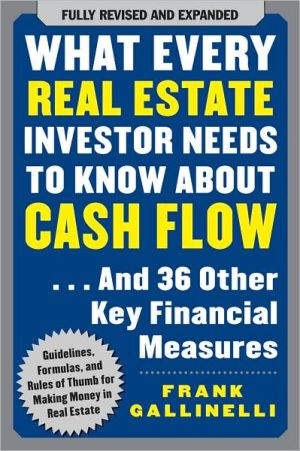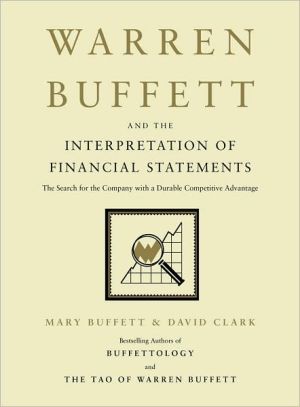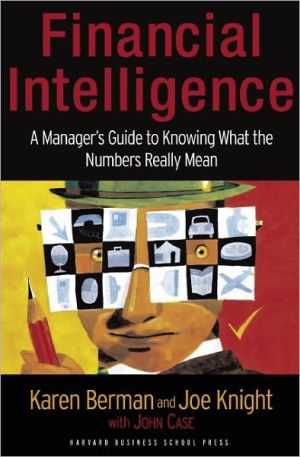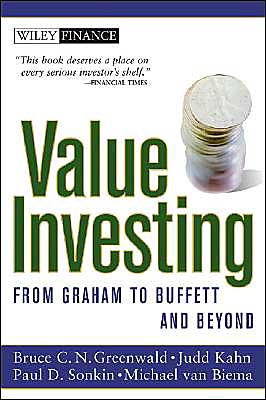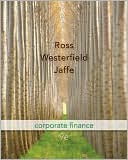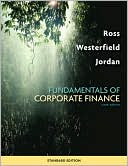What Every Real Estate Investor Needs to Know about Cash Flow... and 36 Other Key Financial Measures
Formulas that make the difference between making profits and losing equity\ \ \ \ \ The only way to win the real estate investing game is by mastering the numbers. This revised and updated edition of the popular reference shows how to target the best investments in the present market. It answers all your real estate questions, and provides new discussions of capital accumulation and internal rate of return. This book’s basic formulas will help you measure critical aspects of real estate...
Search in google:
Formulas that make the difference between making profits and losing equityThe only way to win the real estate investing game is by mastering the numbers. This revised and updated edition of the popular reference shows how to target the best investments in the present market. It answers all your real estate questions, and provides new discussions of capital accumulation and internal rate of return. This book’s basic formulas will help you measure critical aspects of real estate investments, including• Discounted Cash Flow• Net Present Value• Capitalization Rate• Cash-on-Cash Return• Net Operating Income• Internal Rate of Return• Profitability Index• Return on Equity
WHAT EVERY REAL ESTATE INVESTOR NEEDS TO KNOW ABOUT CASH FLOW\ ... And 36 Other Key Financial Measures \ \ By FRANK GALLINELLI \ McGraw-Hill, Inc.\ Copyright © 2009 The McGraw-Hill Companies, Inc.\ All right reserved.\ ISBN: 978-0-07-160327-0 \ \ \ Chapter One\ Do Your Homework: How to Gather the Data Needed to Make an Investment Decision \ Before you delve into the basic calculations that underlie all real estate investments, you need to address a very fundamental issue: You can't calculate anything and you can't make projections unless you have the raw data with which to start. Information is a valuable commodity; you shouldn't start off with any illusions that good information will fall into your lap without some effort on your part.\ These guidelines are necessarily somewhat general. Data will be easier to find in some localities than in others, even within some transactions than in others. Still, if stock market debacles like Enron and WorldCom have taught us anything, it's that investors need to know what's really going on. You owe it to yourself to get the facts. The consequences of doing less can be unpleasant.\ Property-Related Data\ If you're considering the purchase of an income property, you need to know as much as you can about its income and expenses. As we will emphasize throughout this book, you are not really buying a physical property so much as you are buying its income stream. The beauty is in the bottom line.\ If you're considering the purchase of an income property, the information you receive will probably come either directly from the seller or indirectly through the seller's agent. In the next chapter, you'll see in considerable detail how to analyze the basic income and expense numbers, but your first concern here is, "Are they accurate?" Here are some ways that can help you find out.\ Ask to See the Leases\ There are a lot of good reasons to do this. For one, if you buy the property, you are going to be subject to the terms of those leases, so it's a very good idea to know what they say. More to the immediate point, however, is the question of the rental rates. Do the leases agree with the seller's representations? How long does each lease run? Do tenants have options to renew, and at what rates? The answers to these questions will have an important effect on your analysis of the current figures and on the forecasts you'll make about the property's future performance.\ Look at the Property Tax Bill\ That's one way to confirm the accuracy of this expense; but also look to see if the current owner has received some sort of tax abatement (perhaps a development incentive) that may expire or may not apply at all to a new owner. Also, look for evidence of a "phase-in" of a new assessment. Some cities, in order to mitigate the impact that the periodic reassessment of property values can cause, will choose to implement a new assessment in phases. This can mean that the current taxes are accurate, but that there is also the certainty of higher tax bills as the new assessment comes online.\ Spot-check Utility Bills\ Most gas, electric, and water companies will give you usage information if you call. This is not the most efficient way to collect expense data on a property, but it can still serve a useful purpose. If what you find matches what the seller has told you, then you can have some reasonable hope that other representations will also be accurate. If, on the other hand, you discover discrepancies, you can ask for an explanation. Even if what you uncovered turns out to be an honest mistake, you've served notice that you are not to be trifled with when it comes to truth and accuracy.\ Ask to See the Appropriate Sections of the Seller's Tax Return\ You'll have to cover your ears when you try this, because the screaming can be painful. When the din subsides, point out that you don't need to see anything unrelated to the property. If the owner holds the property as an individual, then the income and expense information probably appears on Schedule E, and he or she can show you just that form. The owner may own the property as a limited liability company (LLC) or some other form of partnership, in which case the property has its own tax return. It is quite unlikely that an owner will claim too much income or too little expense on a tax return, so this can be an illuminating source of information.\ Recite the Representations about the Leases and the Schedule of Rent Income in the Offer to Purchase\ Check with an attorney about the proper language, but put into the offer to purchase something along the lines of, "The Seller warrants and represents that as of the date of this agreement, the leases are for [such and such amounts] and the expiration dates and renewal options are [whatever]." Then ask the lawyer about adding, "... and that these warranties will survive the delivery of the deed." The first part means the seller swears to tell nothing but the truth and the second part means that he or she is not off the hook if you discover the lie after you complete the purchase. It's amazing how many sellers get religion when faced with having their words immortalized like that in a contract.\ Rule of Thumb: Forget the lawyer jokes and find yourself a good attorney. You need someone with expertise in investment real estate, not necessarily the person who did your last house closing (single-family closings are to attorneys what oil changes are to auto mechanics). A tight purchase contract or a good lease can save you money and grief. I learned the technique described in the preceding paragraph many years ago from a good friend and attorney. I used it in a purchase offer where the seller was a pleasant, white-haired grandmother with tenants who rented month-to-month. When I presented a purchase offer with an attached rent schedule and a statement warranting that the rents were true, all pleasantries promptly disappeared and I was informed that "... Tenant A would be paying such and so, but he takes out the trash for the building so I charge him less, and Tenant B could be paying what I quoted, but he shovels the snow, etc."\ Market-Related Data\ Investigate Comparable Sales\ If you were contemplating the purchase of a home, you would want to know how much other homes in the neighborhood had sold for. Sales of comparable properties don't tell you as much about an investment property as they do about home sales, but they can sometimes provide a useful insight. There are some obvious problems with trying to use raw "comps" data that you typically get from a real estate agent. One problem is simply the lack of enough comparables to be meaningful. Let's say that you're looking at a 10,000 square foot shopping center. How many recent sales of centers the same size in the same market area are you likely to find? Probably not enough to provide a significant sample.\ Your search might be a bit more productive if you look at some additional factors in regard to these comparables. Total square footage is one. You may find that three strip centers have sold in the last year, but each was a different size. You could examine the selling prices per square foot to see if you can discern a trend. You could also consider each property's gross rent. Dividing the selling price by the gross rent gives you something called the gross rent multiplier (more on this in Part II, Calculation 5). Perhaps you'll get lucky and see that these other three sales occurred at 7.1, 7.2, and 7.3 times each property's gross rent.\ Where do you find data like this? Public records from the tax assessor and city clerk will probably yield sale prices and property dimensions, but digging this out may be a chore. A growing number of Internet sites are dedicated to aggregating information about commercial properties sold and for sale. We could name some here, but we won't because their Internet addresses will probably change before the ink dries on this page. Nonetheless, a Web search should quickly point you to current sources. Also, check the Web sites of trade organizations like the Appraisal Institute (appraisalinstitute.org); they will almost certainly direct you to sources of data. Keep in mind, however, that you are not likely to find this kind of information online without having to pay for it.\ If you're dealing with a broker, he or she should be a great source of information. Even before computers made it easy to keep property records, good commercial brokers always accumulated data about every property they came in contact with. Ask for it.\ One final word on comparable sales data as they relate to income-producing real estate. Remember your mantra: You're really buying the income stream. Comparable sales data are useful insofar as they give us a feel for your market. Data seldom tell you enough by themselves, however, to lead you to a decision about buying or selling.\ Look for Lease Rates and Operating Expense Data\ As you get into serious property analysis and projections, you need to know what tenants are willing to pay for space and how much owners are obliged to pay for operating expenses. Once again, you can ask the commercial broker to share that information. It would be a good idea to cozy up to a property manager as well (you may need his or her services later) because a manager will have firsthand knowledge of what it really costs to run a particular kind of property.\ Find Out about Local Capitalization Rates\ Unless you read this book from the back to the front, you may not know yet what a capitalization rate is. Suffice it to say for now that it's one of several rate-of-return measurements that you will want to know. For the type of financial forecasting you'll learn to perform, it's very valuable to know what the typical capitalization rate is for a particular kind of property in a particular geographic area. Once again, your commercial broker is the first person to ask. This information is more difficult to find online, so despite our reluctance to name commercial Web sites we will mention realtyrates.com as a current source of such data.\ Armed with the confidence that you can dig up the data you need to perform a sensible property analysis, turn your sights now onto some real numbers.\ Chapter Two\ Financial Detective Work Before You Buy: Finding the Truth Behind What the Seller Is Telling You \ Whether you own a shopping mall in the suburbs or a duplex around the corner, the basic principle of income property remains essentially the same. You expect to collect money, mainly in the form of rent, and you expect to spend money to pay for the operating expenses and the loans against the property. When you're done for the year, you hope to have a surplus and to keep as much of it as you can in your own pocket and out of the hands of the tax collector. Perhaps someday you can also sell the property at a handsome profit. In other words, you're looking for cash flow, appreciation, amortization, and tax shelter—the four basic returns.\ To achieve these goals, you, as an investor, need to take a careful and critical look at the income and expense data of any property you consider purchasing. Later, when you're ready to sell, a buyer can examine your own figures with the same critical eye to get a fairly realistic picture of the price your property may then command.\ In this chapter, you'll take a detailed look at the income-and-expense statement for real estate, commonly called the annual property operating data (APOD). You'll consider how these data can be used as a guide in evaluating the performance of a property and how they can serve to signal the presence of possible problem areas.\ Basic Definitions\ Begin your analysis of income and expenses by reviewing a few terms.\ Gross scheduled income is the total annual rent value of all units in the property. This amount includes the actual rent generated by occupied units, as well as the potential rent from vacant units.\ Vacancy allowance is usually expressed as a percentage of the gross scheduled income. As its name suggests, it is an estimate of the amount of potential income that will be lost due to vacancy. Some investors prefer to call this category "vacancy and credit loss" so that it also accounts for uncollectable rent.\ Gross operating income (GOI) is the gross scheduled income, less the vacancy allowance. It is also known as effective gross income. In short, it is the amount you actually collect.\ Operating expenses are items such as property insurance and taxes, repairs, utilities, and management fees. Operating expenses include any costs that are necessary to keep the revenue stream flowing. Mortgage payments and depreciation are not considered operating expenses, nor are capital improvements.\ Net operating income (NOI) is the gross operating income, less the operating expenses. In other words, it is what is left of your total potential income after all vacancy and expense items have been subtracted. Again, mortgage payments and capital expenditures have no impact on the NOI.\ Annual property operating data (APOD) is the real estate equivalent of an income-and-expense statement. You'll use the terms APOD and income-and-expense interchangeably.\ Let's take these definitions and see how they might fit into an actual property analysis. Suppose that you're considering the purchase of Property A, a four-unit apartment house. The present owner tells you that each apartment rents for $400 per month and that his operating expenses last year totaled $5,200. You might organize your information in this fashion:\ Gross Scheduled Income 19,200 Less Vacancy Allowance (3%) 576 Gross Operating Income 18,624 Less Operating Expenses 5,200 Net Operating Income 13,424\ The gross scheduled income of $19,200 represents four units at $400 per month for 12 months. Your vacancy allowance is an estimate, as it almost always will be. Ideally, you should base this estimate on your knowledge of market conditions and of comparable properties in the area.\ Rule of Thumb: In the absence of usable market data, many investors like to use a vacancy allowance in the range of 3% to 6%. An exception to this rule of thumb usually occurs in the case of a newly built project that is being leased for the first time. Vacancy during the initial lease-up period can be much higher.\ Conventional wisdom also has it that a property whose actual vacancy history is close to zero has probably been rented at less than market rates. In other words, if you don't experience some vacancy, you're just not charging enough.\ Subtracting a vacancy allowance of 3% from the gross scheduled income gives you a GOI of $18,624. Subtracting your operating expenses of $5,200 then yields an NOI of $13,424.\ You might draw some useful inferences from these basic facts, but you probably should first take a closer look at how this property operates. The next question you would certainly ask is, "Just how was that $5,200 spent?" The seller responds by telling you he spent $2,550 on fuel oil, $130 on electricity, $200 on water, $250 on repairs, $1,270 on property taxes, and $800 on fire and liability insurance.\ Now your APOD looks like this:\ Gross Scheduled Income 19,200 Less Vacancy Allowance (3%) 576 Gross Operating Income 18,624 Less Operating Expenses Insurance 800 Repairs 250 Taxes 1,270 Utilities Electricity 130 Fuel Oil 2,550 Water 200 Total Operating Expenses 5,200 Net Operating Income 13,424\ You can help yourself understand more about this property if you go a step further. You know that your actual collected rent, the GOI, is partially eaten up by your operating expenses. You can determine how big a bite each expense takes out of your income by computing the percentage of GOI that each expense represents. You accomplish this by dividing each expense by the GOI and multiplying the result by 100:\ Gross Scheduled Income 19,200 Less Vacancy Allowance (3%) 576 Gross Operating Income 18,624 Less Operating Expenses Insurance 800 4.30% Repairs 250 1.34% Taxes 1,270 6.82% Utilities Electricity 130 0.70% Fuel Oil 2,550 13.69% Water 200 1.07% Total Operating Expenses 5,200 27.92% Net Operating Income 13,424\ Analyzing Similar Properties\ It would be nice if you had some hard and fast rules to measure this property against (something like: "Heat should not exceed 11% of GOI—this building must need a new furnace"). The fact that there are no such neat, fixed rules doesn't mean there are no rules at all, however. The piece of real estate in this example doesn't exist in a vacuum, and as a potential buyer, you are sure to ask how the operating statement of this property compares with those of other potential investments. At least, that's what you ought to be asking.\ What you really want here is the ability to compare your data to some kind of norms. Your expense percentages may not tell you very much in an isolated example, but they might shed a good deal of light if you could compare them to some reasonable expectations.\ Where are you going to get these norms? We discussed a few sources in the previous chapter. You can ask the real estate broker who is trying to sell you this property. He or she may have compiled data on similar buildings in the area and should certainly be interested in giving you the data you need to make an informed decision to buy. You might talk to a property manager in the area, someone who would have firsthand experience with the costs of operating such a building. You may be fortunate enough to own other properties, whose track records you can turn to for guidance. At the very least, you can go back into the marketplace, look at other properties currently for sale, and examine the operating statements of these other properties that are competing for your investment dollar.\ (Continues...)\ \ \ \ \ Excerpted from WHAT EVERY REAL ESTATE INVESTOR NEEDS TO KNOW ABOUT CASH FLOW by FRANK GALLINELLI Copyright © 2009 by The McGraw-Hill Companies, Inc.. Excerpted by permission of McGraw-Hill, Inc.. All rights reserved. No part of this excerpt may be reproduced or reprinted without permission in writing from the publisher.\ Excerpts are provided by Dial-A-Book Inc. solely for the personal use of visitors to this web site. \ \
Introduction The Four Ways to Make Money in Real EstatePt. I How to Analyze a Potential Real Estate Deal1 Do Your Homework: How to Gather the Data Needed to Make an Investment Decision 32 Financial Detective Work Before You Buy: Finding the Truth Behind What the Seller Is Telling You 93 How the "Time Value of Money" Should Influence Your Real Estate Investing Decisions 274 How to Estimate What an Income Property Is Really Worth 495 Measuring the Return on a Real Estate Investment 71Pt. II Thirty-Seven Calculations Every Real Estate Investor Needs to Know6 Calculation 1: Simple Interest 1057 Calculation 2: Compound Interest 1088 Calculation 3: Rule of 72s 1149 Calculation 4: Present Value of a Future Cash Flow 11610 Calculation 5: Gross Rent Multiplier 12011 Calculation 6: Gross Scheduled Income (Potential Gross Income) 12312 Calculation 7: Vacancy and Credit Loss 12613 Calculation 8: Gross Operating Income (Effective Gross Income) 13014 Calculation 9: Net Operating Income 13415 Calculation 10: Capitalization Rate 14016 Calculation 11: Net Income Multiplier 14617 Calculation 12: Taxable Income 15018 Calculation 13: Cash Flow 16119 Calculation 14: Cash-on-Cash Return 16720 Calculation 15: Sale Proceeds 17221 Calculation 16: Discounted Cash Flow 17722 Calculation 17: Net Present Value 18323 Calculation 18: Profitability Index 18924 Calculation 19: Internal Rate of Return 19225 Calculation 20: Price, Income, and Expenses per Unit 19726 Calculation 21: Price, Income, and Expenses per Square Foot 20027 Calculation22: Operating Expense Ratio 20428 Calculation 23: Debt Coverage Ratio 20829 Calculation 24: Break-Even Ratio 21230 Calculation 25: Return on Equity 21531 Calculation 26: Loan-to-Value Ratio 21832 Calculation 27: Points 22333 Calculation 28: Mortgage Payment/Mortgage Constant 22634 Calculation 29: Principal Balance/Balloon Payment 23035 Calculation 30: Principal and Interest per Period 23536 Calculation 31: Maximum Loan Amount 23937 Calculation 32: Assessed Value, Property Taxes, and Value Indicated by Assessment 24338 Calculation 33: Adjusted Basis 24739 Calculation 34: Depreciation 25040 Calculation 35: Gain on Sale 25441 Calculation 36: Land Measurements 25742 Calculation 37: Building Measurements Gross Building Area, Usable Square Footage, Rentable Square Footage, Loss Ratio, Net Rentable Area 261Appendix 265Index 275
